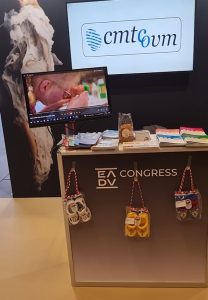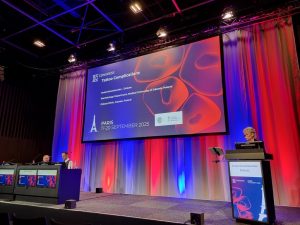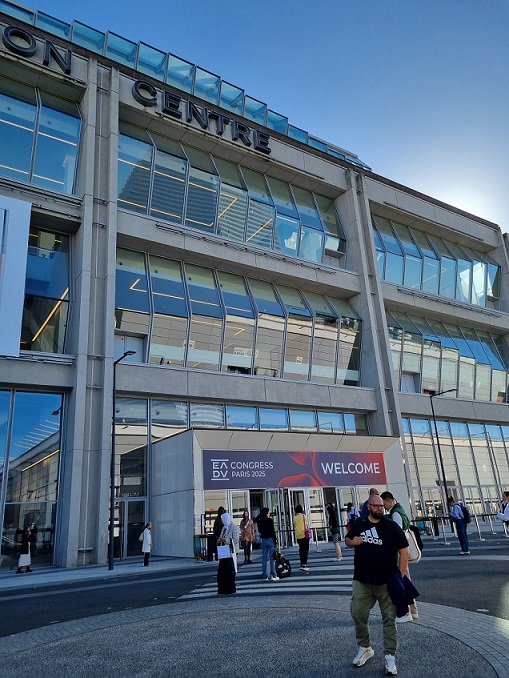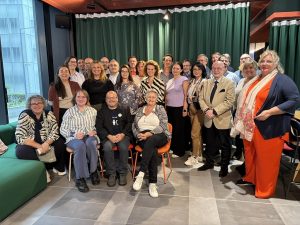The EADV conference was held in Paris from 17–20 September 2025. The total number of participants in Paris exceeded 20,000! In addition, it was also possible to participate online.
On Monday, Lex travelled to Paris to take part in the Global Skin meeting on Tuesday.
The position of Patient Organisations (POs) within the EADV has improved over time. Firstly, the location of our booth is no longer hidden. Secondly, we are now included in the EADV App. Thirdly, the PO Task Force, of which we are a member, is represented on the EADV Board.
This year, 39 POs from around the world were present in Paris.
Tuesday
During the Global Skin meeting on Tuesday, patient organisations (POs) from all over the world were present. By now, more than 300 POs have joined Global Skin.
We discussed the following topics:
- Working together for change. Why advocacy is important in dermatology, key concepts, and the European context.
- Success stories: from idea to impact. Four representatives from different countries presented successful projects. One of the presenters was Dr. Jolien van der Geugten, who shared how she organised a hackathon and what the outcomes were.
- Global in action. Harnessing the power of GRIDD and the WHA Resolution on Skin Diseases.
- Designing targeted advocacy campaigns. This was done through several breakout sessions.
- Creating our common agenda and brainstorming collaborative projects for Global Skin Europe.
Wednesday

At 2 p.m., it was our turn to staff our booth in the Patient Organisation Area. Of course, we had brought not only brochures and booklets but also our traditional small and large stroopwafels. To make our booth even more colourful, we once again brought along the small clog slippers. Experience has shown that the bright colours of these slippers always attract people’s attention.
Over the years, through various conferences where we have hosted a booth, we have met many others, helping to build a global patient community.
That evening, Global Skin organised a welcome reception and networking event, which was very well attended, especially by representatives of patient organisations from all over the world.
Thursday
On Thursday, the EADV Task Force for Patient Organisations was held. This initiative, led by Dr. Bibi van Montfrans and Prof. Dr. Aleksandra Leisak, aims to give patient organisations a voice within the EADV Board. We are also a member of this Task Force and, through this initiative, have already been able to implement several changes — such as improving the location of the Patient Organisation Area.
During the meeting, various discussions took place, and many ideas were collected from the participants — both physicians and representatives of patient organisations — with the goal of taking the next step in strengthening the profile and visibility of patient organisations within the EADV. As a Task Force, we have already achieved a great deal, such as establishing a dedicated Patient Organisation Area, but we aim for even more — for instance, being directly involved in the organisation of EADV congresses.
What stood out this year was the number and diversity of attendees. In previous years, around 20 people usually attended, mostly representatives of patient organisations. This year, however, approximately 60 people were present, including a significant number of doctors and professors. This could indicate that POs are being taken more seriously and are starting to have a real voice. Of course, it remains important that we, as patient organisations, continue to demonstrate our added value for medical professionals. A series of articles on this topic is available on our website.
Friday

The risks are not limited to the skill of the person applying the tattoo but also include substances in the ink, such as PAHs, which are directly linked to cancer in humans. Additionally, there are other potential risks.
We asked the presenters to prepare a summary of their presentations, which we plan to publish on our website.
The application of AI in dermatology was also discussed in several sessions. This includes tasks such as diagnosing at home, for example checking a mole to determine whether it could be malignant.
The conclusion was that AI will certainly play an increasingly important role, but the reliability depends heavily on the data used. If an AI application is not properly trained for specific cases, the outcomes cannot be trusted.
Another session focused on wound healing, with Dr. Bibi van Montfrans as one of the presenters. She is a dermatologist at Erasmus MC in Rotterdam, the Netherlands, and will also give a presentation during our 2025 members’ conference.

